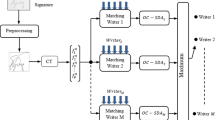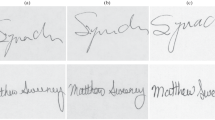Abstract
The application of online signature is promising. However, its huge intra-individual variability and its extremely low inter-class distance brought by forged signatures make it difficult for even state-of-the-art online signature algorithms to be applied in practical scenarios on a large scale. This paper proposes a semantic-driven extraction method of high discriminative features for writer-independent online signature verification, addressing the problem of representation learning with high discriminative features. The semantic-driven model aims at learning the high-level semantic representation of the writer’s inherent signature habits, and it has combined the advantages of LSTM and CNN. Furthermore, several global feature descriptors are designed to extract writer habitual features such as speed, and writing pressure at keystroke positions. The most difficult, writer-independent, 1v1 experiments on the three benchmark data sets of MCYT-100, SUSIG, and MOBISIG were performed, and the results show that the performance of the proposed method is better than that of the state-of-the-art methods, and its performance on the MCYT-100 dataset is 16% higher than the second-best method.








Similar content being viewed by others
References
Ahrabian K, Babaali B (2019) On usage of autoencoders and siamese networks for online handwritten signature verification. Neural Comput Applic 31 (12):9321–9334. https://doi.org/10.1007/s00521-018-3844-z
Alexandre D, Chang C-P, Peng W-H, Hang H-M (2018) An autoencoder-based learned image compressor: Description of challenge proposal by nctu. In: Proceedings of the IEEE Conference on Computer Vision and Pattern Recognition Workshops. p 2539–2542, DOI https://doi.org/10.48550/arXiv.1902.07385
Antal M, Szabó LZ, Tordai T (2018) Online signature verification on mobisig finger-drawn signature corpus. Mob Inf Syst 2018:1–16. https://doi.org/10.1155/2018/3127042
Caruana M, Vera-Rodriguez R, Tolosana R (2021) Analysing and exploiting complexity information in on-line signature verification. In: ICPR International Workshops and Challenges: Virtual Event. Springer International Publishing, p 501–513, DOI https://doi.org/10.1007/978-3-030-68821-9_42
Chandra S, Singh KK, Kumar S, Ganesh K, Sravya L, Kumar BP (2021) A novel approach to validate online signature using machine learning based on dynamic features. Neural Comput Applic 33:1–20. https://doi.org/10.1007/s00521-021-05838-6
Diaz M, Ferrer MA, Impedovo D, Malik MI, Pirlo G, Plamondon R (2019) A perspective analysis of handwritten signature technology. ACM Comput Surv (Csur) 51(6):1–39. https://doi.org/10.1145/3274658
Diaz M, Ferrer MA, Quintana JJ (2019) Anthropomorphic features for on-line signatures. IEEE Trans Patt Anal Mach Intell 41(12):2807–2819. https://doi.org/10.1109/TPAMI.2018.2869163
Diaz M, Fischer A, Ferrer. MA, Plamondon R (2018) Dynamic signature verification system based on one real signature. IEEE Trans Cybern 48 (1):228–239. https://doi.org/10.1109/TCYB.2016.2630419
Diaz M, Fischer A, Plamondon R, Ferrer MA (2015) Towards an automatic on-line signature verifier using only one reference per signer. In: 2015 13th International Conference on Document Analysis and Recognition (ICDAR). p 631–635, DOI https://doi.org/10.1109/ICDAR.2015.7333838
Fiérrez-Aguilar J, Nanni L, Lopez-Pealba J, Ortega-Garcia J, Maltoni D (2005) An on-line signature verification system based on fusion of local and global information. In: Lecture Notes in Computer Science, vol 3087. p 523–532, DOI https://doi.org/10.1007/978-3-540-25976-3_27
Gal Y, Ghahramani Z (2016) A theoretically grounded application of dropout in recurrent neural networks. Adv Neural Inf Process Syst 29:1019–1027. https://doi.org/10.48550/arXiv.1512.05287
Ghosh R (2021) A recurrent neural network based deep learning model for offline signature verification and recognition system. Expert Syst Appl 168:114249. https://doi.org/10.1016/j.eswa.2020.114249
Graves A, Fernández S, Schmidhuber J (2005) Bidirectional lstm networks for improved phoneme classification and recognition. In: International conference on artificial neural networks. Springer, p 799–804, DOI https://doi.org/10.1007/11550907_126
Gupta D, Rani S, Ahmed SH, Verma S, Ijaz MF, Shafi J (2021) Edge caching based on collaborative filtering for heterogeneous icn-iot applications. Sensors 21(16):1–17. https://doi.org/10.1109/TETC.2018.2865345
Guru D, Manjunatha K, Manjunath S, Somashekara M (2017) Interval valued symbolic representation of writer dependent features for online signature verification. Exp Syst Appl 80:232–243. https://doi.org/10.1016/j.eswa.2017.03.024
Hadsell R, Chopra S, LeCun Y (2006) Dimensionality reduction by learning an invariant mapping. In: 2006 IEEE Computer Society Conference on Computer Vision and Pattern Recognition (CVPR’06), vol 2. p 1735–1742, DOI https://doi.org/10.1109/CVPR.2006.100
Hajihashemi V, Arab Ameri MM, Alavi Gharahbagh A, Bastanfard A (2020) A pattern recognition based holographic graph neuron for persian alphabet recognition. In: 2020 International Conference on Machine Vision and Image Processing (MVIP), p 1–6, DOI https://doi.org/10.1109/MVIP49855.2020.9116913
Huang Z, Xu W, Yu K (2015) Bidirectional lstm-crf models for sequence tagging. https://doi.org/10.48550/arXiv.1508.01991
Impedovo D, Pirlo G (2021) Automatic signature verification in the mobile cloud scenario: survey and way ahead. IEEE Trans Emerg Top Comput 9 (1):554–568. https://doi.org/10.1109/TETC.2018.2865345
Impedovo D, Pirlo G (2021) Automatic signature verification in the mobile cloud scenario: Survey and way ahead. IEEE Trans Emerg Top Comput 9(1):554–568. https://doi.org/10.1109/TETC.2018.2865345
Jampour M, Abbaasi S, Javidi M (2021) Capsnet regularization and its conjugation with resnet for signature identification
Jia Y, Huang L, Chen H (2019) A two-stage method for online signature verification using shape contexts and function features. Sensors 19(8):1808. https://doi.org/10.3390/s19081808
Kholmatov A, Yanikoglu B (2009) Susig: an on-line signature database, associated protocols and benchmark results. Pattern Anal Applic 12(3):227–236. https://doi.org/10.1007/s10044-008-0118-x
Lai S, Jin L (2019) Recurrent adaptation networks for online signature verification. IEEE Trans Inf Forensic Secur 14(6):1624–1637. https://doi.org/10.1109/TIFS.2018.2883152
Lai S, Jin L, Yang W (2017) Online signature verification using recurrent neural network and length-normalized path signature descriptor. In: 2017 14th IAPR international conference on document analysis and recognition (ICDAR), vol 1. IEEE, p 400–405, DOI https://doi.org/10.1109/ICDAR.2017.73
Li C, Zhang X, Lin F, Wang Z, Liu J, Zhang R, Wang H (2019) A stroke-based rnn for writer-independent online signature verification. In: 2019 International Conference on Document Analysis and Recognition (ICDAR). p 526–532, DOI https://doi.org/10.1109/ICDAR.2019.00090
Liu Y, Yang Z, Yang L (2015) Online signature verification based on dct and sparse representation. IEEE Trans Cybern 45(11):2498–2511. https://doi.org/10.1109/TCYB.2014.2375959
Minoofam SAH, Bastanfard A, Keyvanpour MR (2021) Trcla: a transfer learning approach to reduce negative transfer for cellular learning automata
Modhej N, Bastanfard A, Teshnehlab M, Raiesdana S (2020) Pattern separation network based on the hippocampus activity for handwritten recognition. IEEE Access 8:212803–212817. https://doi.org/10.1109/ACCESS.2020.3040298
Mohammed RA, Nabi RM, Mahmood SM-R, Nabi RM (2015) State-of-the-art in handwritten signature verification system. In: 2015 International Conference on Computational Science and Computational Intelligence (CSCI). p 519–525, DOI https://doi.org/10.1109/CSCI.2015.180
Okawa M (2020) Online signature verification using single-template matching with time-series averaging and gradient boosting. Pattern Recogn 102:107227. https://doi.org/10.1109/IWCIA47330.2019.8955083
Okawa M (2021) Time-series averaging and local stability-weighted dynamic time warping for online signature verification. Pattern Recogn 112:107699. https://doi.org/10.1016/j.patcog.2020.107699
Ortega-Garcia J, Fierrez-Aguilar J, Simon D, Gonzalez J, Faundez-Zanuy M, Espinosa V, Satue A, Hernaez I, Igarza J-J, Vivaracho C et al (2003) Mcyt baseline corpus: a bimodal biometric database. IEE Proc-Vis Image Signal Process 150(6):395–401. https://doi.org/10.1049/ip-vis:20031078
Pal S, Alaei A, Pal U, Blumenstein M (2015) Interval-valued symbolic representation based method for off-line signature verification. In: 2015 International Joint Conference on Neural Networks (IJCNN). p 1–6, DOI https://doi.org/10.1109/IJCNN.2015.7280518
Pirlo G, Cuccovillo V, Diaz-Cabrera M, Impedovo D, Mignone P (2015) Multidomain verification of dynamic signatures using local stability analysis. IEEE Trans Hum-Mach Syst 45(6):805–810. https://doi.org/10.1109/THMS.2015.2443050
Rani S, Koundal D, Kavita, Ijaz MF, Elhoseny M, Alghamdi MI (2021) An optimized framework for wsn routing in the context of industry 4.0. Sensors 21(19):1–15. https://doi.org/10.3390/s21196474
Sae-Bae N, Memon N (2014) Online signature verification on mobile devices. IEEE Trans Inf Forensic Secur 9(6):933–947. https://doi.org/10.1109/TIFS.2014.2316472
Sae-Bae N, Memon N, Sooraksa P (2018) Distinctiveness, complexity, and repeatability of online signature templates. Pattern Recogn 84:332–344. https://doi.org/10.1016/j.patcog.2018.07.024
Sharma A, Sundaram S (2018) On the exploration of information from the dtw cost matrix for online signature verification. IEEE Trans Cyberne 48 (2):611–624. https://doi.org/10.1109/TCYB.2017.2647826
Srinivasu PN, SivaSai JG, Ijaz MF, Bhoi AK, Kim W, Kang JJ (2021) Classification of skin disease using deep learning neural networks with mobilenet v2 and lstm. Sensors 21(8):1–27. https://doi.org/10.3390/s21082852
Tang L, Kang W, Fang Y (2018) Information divergence-based matching strategy for online signature verification. IEEE Trans Inf Forensic Secur 13(4):861–873. https://doi.org/10.1109/TIFS.2017.2769023
Tolosana R, Delgado-Santos P, Perez-Uribe A, Vera-Rodriguez R, Fierrez J, Morales A (2021) Deepwritesyn: on-line handwriting synthesis via deep short-term representations. In: Proceedings of the AAAI Conference on Artificial Intelligence, vol 35. p 600–608. https://arxiv.org/abs/2009.06308
Tolosana R, Vera-Rodriguez R, Fierrez J, Ortega-Garcia J (2018) Exploring recurrent neural networks for on-line handwritten signature biometrics. IEEE Access 6:5128–5138. https://doi.org/10.1109/ACCESS.2018.2793966
Tolosana R, Vera-Rodriguez R, Fierrez J, Ortega-Garcia J (2021) Deepsign: deep on-line signature verification. IEEE Trans Biom Behav Identity Sci 3(2):229–239. https://doi.org/10.1109/TBIOM.2021.3054533
Vera-Rodriguez R, Tolosana R, Caruana M, Manzano G, Gonzalez-Garcia C, Fierrez J, Ortega-Garcia J (2019) Deepsigncx: signature complexity detection using recurrent neural networks. In: 2019 International Conference on Document Analysis and Recognition (ICDAR). p 1326–1331, DOI https://doi.org/10.1109/ICDAR.2019.00214
Vorugunti CS, Gorthi RKS, Pulabaigari V (2019) Online signature verification by few-shot separable convolution based deep learning. In: 2019 International Conference on Document Analysis and Recognition (ICDAR). p 1125–1130, DOI https://doi.org/10.1109/ICDAR.2019.00182
Vorugunti CS, Pulabaigari V, Gorthi RKSS, Mukherjee P (2020) Osvfusenet: online signature verification by feature fusion and depth-wise separable convolution based deep learning. Neurocomputing 409:157–172. https://doi.org/10.1016/j.neucom.2020.05.072
Xia X, Chen Z, Luan F, Song X (2017) Signature alignment based on gmm for on-line signature verification. Pattern Recog 65:188–196. https://doi.org/10.1016/j.patcog.2016.12.019
Xia X, Song X, Luan F, Zheng J, Chen Z, Ma X (2018) Discriminative feature selection for on-line signature verification. Pattern Recog 74:422–433. https://doi.org/10.1016/j.patcog.2017.09.033
Yang L, Cheng Y, Wang X, Liu Q (2018) Online handwritten signature verification using feature weighting algorithm relief. Soft Comput 22 (23):7811–7823. https://doi.org/10.1007/s00500-018-3477-2
Acknowledgements
This work has been partially supported by the Key scientific research fund of Xihua University (Grant No: Z17134), Xihua University Key Laboratory Development Program (Grant No: szjj2017-065), Xihua University Graduate Innovation Fund Research Project (Grant No: YCJJ2021032) and Sichuan science and technology program (Grant No: 2021YFG0022,2019YFG0108).
Author information
Authors and Affiliations
Corresponding author
Ethics declarations
Conflict of Interests
The authors declare that there is no any conflict of interest.
Additional information
Publisher’s note
Springer Nature remains neutral with regard to jurisdictional claims in published maps and institutional affiliations.
Rights and permissions
Springer Nature or its licensor (e.g. a society or other partner) holds exclusive rights to this article under a publishing agreement with the author(s) or other rightsholder(s); author self-archiving of the accepted manuscript version of this article is solely governed by the terms of such publishing agreement and applicable law.
About this article
Cite this article
Long, J., Xie, C. & Gao, Z. High discriminant features for writer-independent online signature verification. Multimed Tools Appl 82, 38447–38465 (2023). https://doi.org/10.1007/s11042-023-14638-0
Received:
Revised:
Accepted:
Published:
Issue Date:
DOI: https://doi.org/10.1007/s11042-023-14638-0




